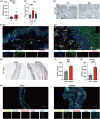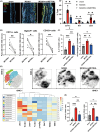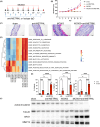Meteorin-like protein/METRNL/Interleukin-41 ameliorates atopic dermatitis-like inflammation
- PMID: 38727640
- PMCID: PMC11804313
- DOI: 10.1111/all.16150
Meteorin-like protein/METRNL/Interleukin-41 ameliorates atopic dermatitis-like inflammation
Abstract
Background: Meteorin-like protein (METRNL)/Interleukin-41 (IL-41) is a novel immune-secreted cytokine/myokine involved in several inflammatory diseases. However, how METRNL exerts its regulatory properties on skin inflammation remains elusive. This study aims to elucidate the functionality and regulatory mechanism of METRNL in atopic dermatitis (AD).
Methods: METRNL levels were determined in skin and serum samples from patients with AD and subsequently verified in the vitamin D3 analogue MC903-induced AD-like mice model. The cellular target of METRNL activity was identified by multiplex immunostaining, single-cell RNA-seq and RNA-seq.
Results: METRNL was significantly upregulated in lesions and serum of patients with dermatitis compared to healthy controls (p <.05). Following repeated MC903 exposure, AD model mice displayed elevated levels of METRNL in both ears and serum. Administration of recombinant murine METRNL protein (rmMETRNL) ameliorated allergic skin inflammation and hallmarks of AD in mice, whereas blocking of METRNL signaling led to the opposite. METRNL enhanced β-Catenin activation, limited the expression of Th2-related molecules that attract the accumulation of Arginase-1 (Arg1)hi macrophages, dendritic cells, and activated mast cells.
Conclusions: METRNL can bind to KIT receptor and subsequently alleviate the allergic inflammation of AD by inhibiting the expansion of immune cells, and downregulating inflammatory gene expression by regulating the level of active WNT pathway molecule β-Catenin.
Keywords: Meteorin‐like protein (METRNL); WNT signaling pathways; atopic dermatitis; cytokines; skin inflammation.
© 2024 The Authors. Allergy published by European Academy of Allergy and Clinical Immunology and John Wiley & Sons Ltd.
Conflict of interest statement
Ms. Huang, Ms. Liu, Dr. Gao, Dr. Choi, Mr. Giglio, Mr. Farah, Dr. Leung, Ms. Wong, Dr. Kan, Mr. Chong, Dr. Meng, Dr. Liao, Dr. Cheung and Dr. Wong have nothing to disclose.
Figures






References
-
- Esaki H, Brunner PM, Renert‐Yuval Y, et al. Early‐onset pediatric atopic dermatitis is TH2 but also TH17 polarized in skin. J Allergy Clin Immunol. 2016;138:1639‐1651. - PubMed
-
- Vandeghinste N, Klattig J, Jagerschmidt C, et al. Neutralization of IL‐17C reduces skin inflammation in mouse models of psoriasis and atopic dermatitis. J Invest Dermatol. 2018;138:1555‐1563. - PubMed
MeSH terms
Substances
Grants and funding
LinkOut - more resources
Full Text Sources
Research Materials
Miscellaneous

